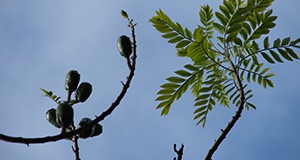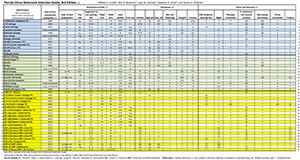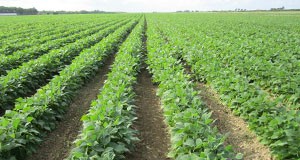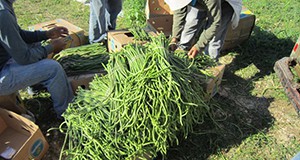 Food diversity, nutritional food supply, and profitability are the priorities of agricultural and horticultural industries. To diversify vegetable products and increase the Florida vegetable industry's competitiveness, a number of new vegetable crops are rapidly emerging in the state. Due to Florida's favorable climate, these vegetable crops grow well and have high market potential. The objective of this 6-page fact sheet is to provide a general overview of long bean, one of the Asian vegetable crops grown in Florida. Written by Kshitij Khatri, Guodong Liu, Qingren Wang, Yuncong Li, David Dinkins, and Bonnie Wells, and published by the UF Department of Horticultural Sciences, October 2015.
Food diversity, nutritional food supply, and profitability are the priorities of agricultural and horticultural industries. To diversify vegetable products and increase the Florida vegetable industry's competitiveness, a number of new vegetable crops are rapidly emerging in the state. Due to Florida's favorable climate, these vegetable crops grow well and have high market potential. The objective of this 6-page fact sheet is to provide a general overview of long bean, one of the Asian vegetable crops grown in Florida. Written by Kshitij Khatri, Guodong Liu, Qingren Wang, Yuncong Li, David Dinkins, and Bonnie Wells, and published by the UF Department of Horticultural Sciences, October 2015.
http://edis.ifas.ufl.edu/hs1268
Tag: Horticultural Sciences Department
Maximizing Weed Control in Florida Citrus
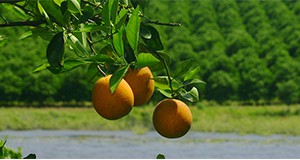
With Florida citrus growers and production managers being “squeezed” between rising production prices and declining yields from citrus greening, there’s more call than ever to reduce citrus production costs. Controlling weeds is a major expense, amounting to 11% of the total $2,278 annual production cost per acre for the 2014–2015 season. This 3-page fact sheet teaches the six essential components of an effective weed-management program to help maintain the profitability of this vital Florida industry. Written by Stephen H. Futch and Brent Sellers and published by the Horticultural Sciences Department. http://edis.ifas.ufl.edu/hs237
Mechanical Pruning of Citrus Trees
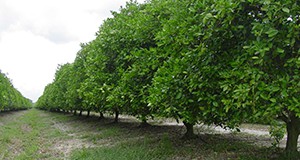
When citrus trees are not regularly pruned, less sunlight reaches the lower parts of the trees, which can reduce flowering and fruit development, quality, and color. Less sunlight also increases the risk of fungal infection. This 3-page fact sheets explains how growers can prune trees to maximize light exposure. Written by Mongi Zekri, and published by the UF Department of Horticultural Sciences, August 2015.
http://edis.ifas.ufl.edu/hs1267
Resetting in Citrus Groves
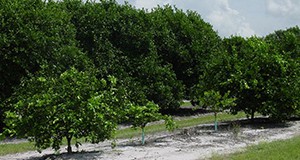
To maintain the overall productivity of a citrus grove, dead or declining trees should be promptly removed and replaced with young, healthy trees, a practice known as resetting. Resetting presents many challenges for growers because young trees require more attention and care than more established trees. This 4-page fact sheet discusses effective resetting methods and maintenance for citrus. Written by Zekri Mongi, and published by the UF Department of Horticultural Sciences, August 2015.
http://edis.ifas.ufl.edu/hs1266
What is 4R nutrient stewardship?
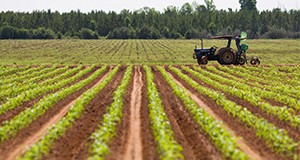
A new and innovative approach to Best Management Practices for fertilizer application known as 4R nutrient stewardship is available, to ensure the environmental, social, and economical sustainability of commercial crop production. This 3-page fact sheet focuses on the basic concepts of the 4R nutrient stewardship principles for commercial crop production. Written by Guodong Liu, Kelly Morgan, Yuncong Li, Lincoln Zotarelli, James DeValerio, and Qingren Wang, and published by the UF Department of Horticultural Sciences, July 2015.
http://edis.ifas.ufl.edu/hs1264
Fungal Gummosis in Peach
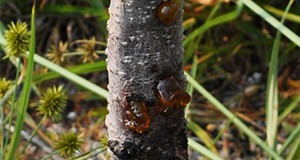
Fungal gummosis in peach occurs when the fungus Botryosphaeria dothidea infects small openings or wounds in tree branches or trunks. The disease causes blisters on the tree that form lesions and eventually ooze gum (sap). This 3-page fact sheet covers the disease cycle and management of fungal gummosis in peach, which is often difficult to control. Written by Sara Sherman, Mercy Olmstead, Philip Harmon, and Thomas Beckman, and published by the UF Department of Horticultural Sciences, July 2015.
http://edis.ifas.ufl.edu/hs1265
Peach Rust
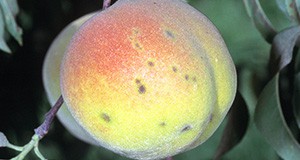
Peach rust is a fungal disease that affect the leaves and, less commonly, twigs and fruit of peach trees. The fungus that causes peach rust thrives in Florida’s humid climate and may cause significant economic losses in severely affected orchards. This 5-page fact sheet details peach rust symptoms, disease cycle, and management, including fungicide treatments. Written by Courtney Ligon, Mercy Olmstead, and Phillip Harmon, and published by the UF Department of Horticultural Sciences, June 2015.
http://edis.ifas.ufl.edu/hs1263
Spondias Growing in the Florida Home Landscape
Spondias species (whose common names among English speakers include ambarella, Ataheite apple, mombins, and hog plums) are flowering trees native to tropical and subtropical regions. They are known for their sweet fruit and grow well in the warmest parts of Florida. This 8-page fact sheet discusses biology, distribution and uses, as well as guidelines for propagation and maintenance. Written by Jonathan H. Crane and Jeffrey Wasielewski, and published by the UF Department of Horticultural Sciences, April 2015. (Photo by Forest & Kim Starr, CC BY 3.0)
http://edis.ifas.ufl.edu/mg059
Florida Citrus Rootstock Selection Guide, 3rd Edition
Information about citrus rootstocks has become an important part of understanding and managing citrus greening (Huanglongbing or HLB). This selection guide covers 20 characteristics of 45 citrus rootstocks and explains its methodology in detail. This 3-page fact sheet was written by William S. Castle, Kim D. Bowman, Jude W. Grosser, Stephen H. Futch, and James H. Graham and published by the UF Department of Horticultural Sciences, May 2015.
http://edis.ifas.ufl.edu/hs1260
Snap Bean Soil Fertility Program in Miami-Dade County
In terms of acreage, snap beans are the most commonly grown vegetable in Miami-Dade County. This 2-page facts sheet outlines the impact of fertilizer use and local weather and soil on snap bean production in this region. Written by Monica Ozores-Hampton, Qiang Zhu, and Yuncong Li, and published by the UF Department of Horticultural Sciences, May 2015. http://edis.ifas.ufl.edu/hs1261
The Good, the Bad, and the Ugly: What the Future Could Hold for Bs2 Tomatoes
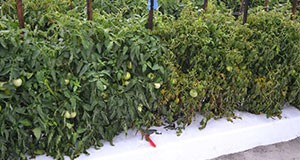 Bs2 tomatoes are transgenic tomatoes that have been engineered to contain the Bs2 gene from pepper. As such, they are considered a genetically modified (GM) food, or a genetically modified organism (GMO). Numerous trials conducted by University of Florida researchers have shown the benefits of these cultivars for bacterial spot disease management, and growers and industry members recognize the potential for Bs2 tomatoes to make Florida tomato production more sustainable. This 4-page fact sheet discusses the benefits that might be realized by the adoption of Bs2 tomato varieties, and the challenges standing in the way of their commercial production. Written by S. F. Hutton, J. W. Scott, J. B. Jones, R. E. Stall, G. E. Vallad, B. J. Staskawicz, and D. M. Horvath , and published by the UF Department of Horticultural Sciences, April 2015.
Bs2 tomatoes are transgenic tomatoes that have been engineered to contain the Bs2 gene from pepper. As such, they are considered a genetically modified (GM) food, or a genetically modified organism (GMO). Numerous trials conducted by University of Florida researchers have shown the benefits of these cultivars for bacterial spot disease management, and growers and industry members recognize the potential for Bs2 tomatoes to make Florida tomato production more sustainable. This 4-page fact sheet discusses the benefits that might be realized by the adoption of Bs2 tomato varieties, and the challenges standing in the way of their commercial production. Written by S. F. Hutton, J. W. Scott, J. B. Jones, R. E. Stall, G. E. Vallad, B. J. Staskawicz, and D. M. Horvath , and published by the UF Department of Horticultural Sciences, April 2015.
http://edis.ifas.ufl.edu/hs1259
Pepper Production in Miami-Dade County, Florida
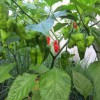 Pepper is an important vegetable crop in Miami-Dade County. Unlike other vegetable crops, peppers are relatively more adaptable to the environment, especially the heat, and are relatively easier to grow. But to be successful, careful attention must be paid to maintain healthy plants and high productivity with efficient management of soil and water for the particular needs of each variety or cultivar. This 7-page fact sheet provides general information and guidelines for pepper growers in Miami-Dade County, including major pepper varieties, and their horticultural traits, and fundamental soil and water management requirements. Written by Qingren Wang, Shouan Zhang, Yuncong Li, Dakshina Seal, Waldemar Klassen, and Teresa Olczyk, and published by the UF Department of Horticultural Sciences, February 2015.
Pepper is an important vegetable crop in Miami-Dade County. Unlike other vegetable crops, peppers are relatively more adaptable to the environment, especially the heat, and are relatively easier to grow. But to be successful, careful attention must be paid to maintain healthy plants and high productivity with efficient management of soil and water for the particular needs of each variety or cultivar. This 7-page fact sheet provides general information and guidelines for pepper growers in Miami-Dade County, including major pepper varieties, and their horticultural traits, and fundamental soil and water management requirements. Written by Qingren Wang, Shouan Zhang, Yuncong Li, Dakshina Seal, Waldemar Klassen, and Teresa Olczyk, and published by the UF Department of Horticultural Sciences, February 2015.
http://edis.ifas.ufl.edu/tr010
Selecting Cultivars of Lettuce For Production Using Hydroponics and Protected Culture in Florida
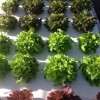 With correct variety selection and protected culture strategies, lettuce is a crop that can present even the novice grower with a fast-growing commodity for market sale. Includes brief descriptions of hydroponic lettuce production systems, cultivars, and a table summarizing the lettuce types successfully grown in Florida using protected agriculture and hydroponic techniques. This 6-page fact sheet was written by Natalie B. Parkell, Robert C. Hochmuth, and Wanda L. Laughlin, and published by the UF Department of Horticultural Sciences, March 2015. (Photo: UF/IFAS)
With correct variety selection and protected culture strategies, lettuce is a crop that can present even the novice grower with a fast-growing commodity for market sale. Includes brief descriptions of hydroponic lettuce production systems, cultivars, and a table summarizing the lettuce types successfully grown in Florida using protected agriculture and hydroponic techniques. This 6-page fact sheet was written by Natalie B. Parkell, Robert C. Hochmuth, and Wanda L. Laughlin, and published by the UF Department of Horticultural Sciences, March 2015. (Photo: UF/IFAS)
http://edis.ifas.ufl.edu/hs1258
Control of Rapid Postharvest Decays of Tomato Fruit
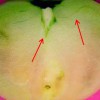 What is a rapid postharvest decay? Water-soaked lesions begin within 12 to 18 hours after harvest and continue to develop, producing large amounts of fluids. The decay spreads within cartons of tomatoes, producing wet patches in the bottom and sides of the container, a condition called “wet-boxes.” Affected fruit are out-of-grade either prior to shipment or upon arrival at the receiver.This 5-page fact sheet was written by J. A. Bartz, S. A. Sargent, and D. J. Huber, and published by the UF Department of Horticultural Sciences, December 2014. (Photo: S. R. Bartz)
What is a rapid postharvest decay? Water-soaked lesions begin within 12 to 18 hours after harvest and continue to develop, producing large amounts of fluids. The decay spreads within cartons of tomatoes, producing wet patches in the bottom and sides of the container, a condition called “wet-boxes.” Affected fruit are out-of-grade either prior to shipment or upon arrival at the receiver.This 5-page fact sheet was written by J. A. Bartz, S. A. Sargent, and D. J. Huber, and published by the UF Department of Horticultural Sciences, December 2014. (Photo: S. R. Bartz)
http://edis.ifas.ufl.edu/hs363
Techniques for Melon Grafting
Grafting as a cultural practice for controlling soilborne diseases and improving abiotic stress tolerance has been widely used in vegetable production in many areas of Asia and Europe. Interest in vegetable grafting has been growing in the United States in recent years, as well. Cost, along with the desire to customize scion cultivars and the need to produce organic transplants, has led many small and organic growers to choose to graft plants by themselves. To help growers who are interested in grafting melon plants achieve a high graft survival rate, this 5-page fact sheet introduces commonly used grafting techniques and their application in specific circumstances. Written by Wenjing Guan and Xin Zhao, and published by the UF Department of Horticultural Sciences, December 2014.
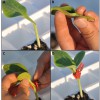 fl.edu/hs1257>http://edis.ifas.ufl.edu/hs1257
fl.edu/hs1257>http://edis.ifas.ufl.edu/hs1257
Hand Pollination of Tomato for Breeding and Seed Production
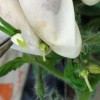 Hand pollination is a technique that is used for breeding new tomato varieties with desirable characteristics such as plant vigor, disease resistance, and uniform fruit quality and plant growth; since tomatoes have complete flowers and are self-pollinated, it usually is unnecessary to hand pollinate the flowers for fruit production. This 4-page guide illustrates selection and emasculation of flowers from the plant receiving pollen, pollen collection and drying, and pollination of the stigma. Written by Monica Ozores-Hampton, and published by the UF Department of Horticultural Sciences, August 2014. (Photo credit: Monica Ozores-Hampton)
Hand pollination is a technique that is used for breeding new tomato varieties with desirable characteristics such as plant vigor, disease resistance, and uniform fruit quality and plant growth; since tomatoes have complete flowers and are self-pollinated, it usually is unnecessary to hand pollinate the flowers for fruit production. This 4-page guide illustrates selection and emasculation of flowers from the plant receiving pollen, pollen collection and drying, and pollination of the stigma. Written by Monica Ozores-Hampton, and published by the UF Department of Horticultural Sciences, August 2014. (Photo credit: Monica Ozores-Hampton)
http://edis.ifas.ufl.edu/hs1248
Controlled-Release and Slow-Release Fertilizers as Nutrient Management Tools
 There are many fertilizer sources available for commercial crop production. The characteristics of each fertilizer type determine whether its use poses an advantage or a disadvantage to a farmer. This 6-page fact sheet focuses on how to select the right fertilizer to enhance profitability and satisfy best management practices (BMPs). Written by Guodong Liu, Lincoln Zotarelli, Yuncong Li, David Dinkins, Qingren Wang, and Monica Ozores-Hampton, and published by the UF Department of Horticultural Sciences, October 2014. (UF/IFAS Photo by Thomas Wright)
There are many fertilizer sources available for commercial crop production. The characteristics of each fertilizer type determine whether its use poses an advantage or a disadvantage to a farmer. This 6-page fact sheet focuses on how to select the right fertilizer to enhance profitability and satisfy best management practices (BMPs). Written by Guodong Liu, Lincoln Zotarelli, Yuncong Li, David Dinkins, Qingren Wang, and Monica Ozores-Hampton, and published by the UF Department of Horticultural Sciences, October 2014. (UF/IFAS Photo by Thomas Wright)
http://edis.ifas.ufl.edu/hs1255
Sensation™ Brand 'Florida127' Strawberry
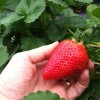 ‘Florida127’ is a new strawberry cultivar released from the University of Florida in 2013, the fruit of which are eligible for marketing under the Sensation™ brand. It is a short-day plant adapted to annual, winter plasticulture growing systems. The plant is moderately compact, robust, and upright with long pedicels, making the fruit easy to harvest. This 4-page fact sheet provides information and recommendations based on several years of testing in field plots in west-central Florida. Comparisons are made to ‘Florida Radiance’ and ‘Strawberry Festival’ for disease resistance. Written by Vance M. Whitaker, Craig K. Chandler, and Natalia A. Peres, and published by the UF Department of Horticultural Sciences, October 2014. (Photo by Vance M. Whitaker)
‘Florida127’ is a new strawberry cultivar released from the University of Florida in 2013, the fruit of which are eligible for marketing under the Sensation™ brand. It is a short-day plant adapted to annual, winter plasticulture growing systems. The plant is moderately compact, robust, and upright with long pedicels, making the fruit easy to harvest. This 4-page fact sheet provides information and recommendations based on several years of testing in field plots in west-central Florida. Comparisons are made to ‘Florida Radiance’ and ‘Strawberry Festival’ for disease resistance. Written by Vance M. Whitaker, Craig K. Chandler, and Natalia A. Peres, and published by the UF Department of Horticultural Sciences, October 2014. (Photo by Vance M. Whitaker)
http://edis.ifas.ufl.edu/hs1256
New Sources of Southern Chinch Bug Resistance in St. Augustinegrass
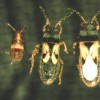 Currently, Captiva is the only chinch bug-resistant variety of St. Augustinegrass grown on sod farms in Florida. But since these pests have previously overcome their resistance to Floratam, it is highly probable that they will do the same with Captiva in the future. It is also desirable to have resistant varieties available with different agronomic qualities such as shade tolerance or drought tolerance. This 4-page fact sheet reports the results of a preliminary screening to detect resistance to chinch bugs, conducted at the UF/IFAS Everglades research station on 36 untested St. Augustinegrass lines. Written by Huangjun Lu and Ronald Cherry, and published by the UF Department of Horticultural Sciences, July 2014.
Currently, Captiva is the only chinch bug-resistant variety of St. Augustinegrass grown on sod farms in Florida. But since these pests have previously overcome their resistance to Floratam, it is highly probable that they will do the same with Captiva in the future. It is also desirable to have resistant varieties available with different agronomic qualities such as shade tolerance or drought tolerance. This 4-page fact sheet reports the results of a preliminary screening to detect resistance to chinch bugs, conducted at the UF/IFAS Everglades research station on 36 untested St. Augustinegrass lines. Written by Huangjun Lu and Ronald Cherry, and published by the UF Department of Horticultural Sciences, July 2014.
http://edis.ifas.ufl.edu/hs1239
Converting from seepage irrigation to plasticulture for vegetable production: a case study and on-farm demonstration
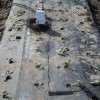 Cabbage production in Florida has been dominated by the use of seepage or sub-irrigation, because it is inexpensive to maintain and simple to use, but it can require vast quantities of water to be pumped from the aquifer in low rainfall years. Plasticulture has been proposed as an alternative production method for cabbage production in Florida. An on-farm demonstration was setup on Greene’s Farms in Bunnell, FL to provide a platform for collaboration between researchers, growers and extension professionals. This 6-page fact sheet illustrates an innovative approach converting from seepage irrigation to plasticulture and points out some options and challenges for growers considering a plasticulture system. Written by Charles E. Barrett, Lincoln Zotarelli, Brian S. Taylor, Lucas G. Paranhos, and Mark Warren, and published by the UF Department of Horticultural Sciences, July 2014.
Cabbage production in Florida has been dominated by the use of seepage or sub-irrigation, because it is inexpensive to maintain and simple to use, but it can require vast quantities of water to be pumped from the aquifer in low rainfall years. Plasticulture has been proposed as an alternative production method for cabbage production in Florida. An on-farm demonstration was setup on Greene’s Farms in Bunnell, FL to provide a platform for collaboration between researchers, growers and extension professionals. This 6-page fact sheet illustrates an innovative approach converting from seepage irrigation to plasticulture and points out some options and challenges for growers considering a plasticulture system. Written by Charles E. Barrett, Lincoln Zotarelli, Brian S. Taylor, Lucas G. Paranhos, and Mark Warren, and published by the UF Department of Horticultural Sciences, July 2014.
http://edis.ifas.ufl.edu/hs1246
